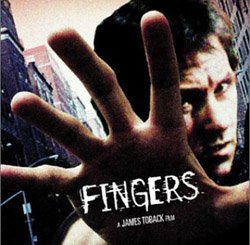
(Image: the "surgeon" from the Guinea Pig movie, Flower of Flesh and Blood -- click the link for an interesting description of the film. You can see what he is operating on here, though I would actually recommend not looking).
Hm. Somehow Friday’s Signal+Noise event ended up being all about gender politics, when it didn’t intend to be. No women performed music – at least not as part of the live show at Video In. Men hit each other, talked to each other, dined with each other onstage, and performed operations and art in equal measure, while women remained on the margins, were rendered “objects” of male performance, or were excluded entirely; by the time, midway through the evening, Jesse Scott Colin & Paul Warren Bennett performed Microclimate – which involved both men eating different courses of food while a female (uncredited in the online program) stood in uniform behind them, ready to take away plates and pour wine for them – some of the women in the audience were getting uppity. One threw a plastic cup in the direction of the stage as a protest; as I heard a woman sitting next to me remark: finally a woman appears, and she’s a servant? In fact, I’d had the same thought myself. Usually women are more widely represented in Vancouver arts events – politics demand it – such that the evening seemed to harken vaguely back to the 1980’s, when it was more common for men to dominate and exclude and make an evening all about themselves. My review will unavoidably hearken back to the humourless good old days of 1980's "pre-post," pre-Madonna, anti-porn, male-bashing feminism, but what can I say, that's where the evening took me.
Certainly none of the performers in the lineup should be held individually responsible for this. The woman who threw the glass could use a lesson in manners, at the very least, and perhaps needs to reflect that she was actually expressing disapproval at the performance that had, in fact, the most active participation from a female, servant or no (the other live woman of the evening, Christine Carriere, as the patient in Turbulent Bodies: An Aesthetic Odyssey, simply lay on a table immobile). Further, the individual performers are not responsible for the context in which they perform – they didn’t conspire to exclude women from the night, which women were indeed involved in arranging (note: Velveeta Krisp did not get any cell phone calls). Probably Microclimate would have seemed quite innocent of any questionable representation of women if the rest of the evening’s line-up had been more balanced. There is an even larger mitigating circumstance that needs to be taken into account, too: very few submissions came in from women – which is believable, since much of what we were listening to was relatively high-tech stuff, a niche that women don’t inhabit in great numbers. Signal+Noise can hardly be blamed for not representing women in equal measure, if almost none applied; and the festival organizers, cognizant of the issue, put out a sign-up sheet for workshops to get more women involved in making electronic music/noise/etc, which shows their hearts were in the right place.
All the same, the sheer maleness of the night did colour reactons to pieces. Austrian artists Stefan Brunner, Michael Wilhelm & Daniel Lercher began the live performances with a piece in which two men, wired with contact mikes, hit each other, producing sound – heartbeats, breaths, thumps, and so forth – in both a ritualistic/rhythmic fashion and in a bit of free sparring. I’d’ve liked to have gotten Michael V. Smith talking on that one – he was sitting beside me; even though we were seeing two shirtless men interacting, the violent nature of their interaction alone seemed to make it strictly heterosexual – as if by punching each other, they were able to fulfill the need for contact without crossing boundaries into queer eroticism. Michael Wilhelm’s photographs, mostly of his own distorted body parts, suggest that there is an erotic awareness in his art (and if anyone has a link to online images of these, I'd like to see them again). Still, the piece seemed more about militarism, competition, repression, and capitalism than it did about men touching; and regardless of its overt political intent (which could be read as a critique of the repression of eroticism among heterosexual men), reality in this piece was a contest between men, where women were insignificant, not even visible in the background.
Several chairs, a table and maybe some magazines by Benjamin Bellas, Justin Cooper and Reed Barrow of Chicago certainly also seems to be about men, in relations to each other that exclude women. Two men engage in a conversation: one a therapist, the other a patient. The patient describes a dream, which involves being watched by an audience who is waiting for something to happen, as the therapist – who, we are told, appeared in the dream – asks him questions. No women are mentioned – as if men in therapy talk about anything but! The routine is performed at first slowly; it comes to an end, and repeated with the main two men switching roles, talking at ever increasing rates. A drummer joins them and adds some rhythm to the routine, and a strange (uncredited) furry-costumed creature begins to wander the audience, hugging members (arguably this was a feminine role -- the hugs seemed nurturing and the body of the beast soft -- but the gender was completely invisible and it didn’t hug me, so who knows how "female" it really was. I’d be curious if there were breasts under all that fur). It was actually a really fun piece to watch, and had the quality of an elaborate game, but the male dominated nature of the night made the piece seem like a commentary on men talking to men, in closed circles, with women nowhere in sight, excluded from discourse, excluded from all but, perhaps, a role in the audience. It’s a man’s world. None of this was part of their intended theme; it was noise, not signal, but, given the context, it was growing difficult to tune it out.
Air Pressure by Michael Lloyd – which followed the restaurant piece – almost seems to have deliberately played off such themes. A trumpet player stands on stage – Lloyd, we assume – and performs, while images of a female face appear, very large and often at the margins of the screen, behind him. The woman seems "framed," unable to escape the screen, ie, her role as the object of the male gaze. Her eyes are occasionally shown in close-up, dominating the screen, staring at the audience as if asking us to acknowledge how trapped she is, staring out from the other side, TRYING to claim some degree of subjectivity by virtue of the intensity of her gaze, but unable to actually step through and speak for herself. At one point the eyes seem to focus on the trumpet player (Blake Smith, in the audience, and I apparently both wondered throughout the piece if the artist was commenting on male narcissism – he doesn’t even look at the woman, is totally involved in his own “performance,” which requires her only as silent spectator/object -- the eternal feminine as the background against which men play with their horns). At one point the woman is shown with her mouth open, such that we can imagine the strangled, discordant sounds of the trumpet coming from her, but she remains just an image on a screen, mute. Again, whether Lloyd intended these readings seems irrelevant (though one suspects he did); given the situation, they were inevitable, unavoidable, writ large on the screen – and in fact, he got points for at least seeming to comment on the silencing of women in our culture.
No points can be given to Dan Kibke or Ole Eldor on this account, though in a gendered reading of the evening, it is entirely fitting that their piece, Turbulent Bodies: An Aesthetic Odyssey, came as the night’s climax. If Lloyd crafted the least “politically problematical” piece of the evening, Kibke and Eldor crafted by far the most (it is hard to hold Christine Carriere to account, since her role, like that of so many women of yore, appears to have been to just lie there). To be aware of the politically problematic nature of their work doesn’t require us to condemn it: one does sense that these guys were TRYING to be creepy and evil, first off, so succeeding at making audiences uncomfortable can hardly be held against them. To give them credit, their piece was by far the most visceral of the night, was visually compelling, and had some very interesting sound texture, succeeding on a level of musical sophistication where many of the previous pieces failed (...though some of the samples they’d recorded themselves sounded just a bit clunky, particularly the in-flight announcements). They managed to craft something very provocative out of very simple sources; and their insensitivity to gender politic issues surely merits them the Brass Balls Trophy of the evening.

(Image from David Cronenberg's Dead Ringers -- it's not up as of this writing, but Moving Pictures will be screening Dead Ringers at the Vancity Theatre on May 18th. A rental, it is not listed in the Vancity online program, though you can find it in their printed guide)
It was simple enough in conception: both men are in surgical scrubs, with Ole in the role of doctor. Sounds are made by Ole and manipulated, along with a host of prerecorded material, including hospital-style beeps, by Dan on laptop. Intially they’d planned to actually draw some sounds from Christine’s body, as she lay there anaesthetized, but apparently their stethoscope/microphone combination didn’t work out. Some of the audio used had Christine taking a “trip,” using announcements by flight attendants and descriptions of flight conditions to represent the interior experience of being under anaesthetic (hence “an aesthetic – anaesthetic – odyssey”). If the video footage they used in the background had followed this theme, probably no one would have cause to be upset – if we’d seen images of an imaginary trip, say, of airplanes, skies, or Christine’s dreams and hallucinations. The piece would probably have been nowhere near as interesting (and required much more work to make, requiring actual filmmaking, rather than the use of found footage), but it wouldn’t have gotten anyone’s hackles up; in fact, we would have had the female, for the first time in the evening, PRODUCING something herself – the figuring of female subjectivity uncontained by male systems of power, dreaming away, free. Feminists in the audience would have been applauding with gratitude and relief. Instead, we were treated to a host of squirm-inducing medical images, taking us “inside” the woman’s body, showing us glistening organs and interior surgical images that could have been lifted from autopsy scenes in Brakhage’s The Act of Seeing with One's Own Eyes. The two men are shown as impassive technicians in impersonal, identity-obscuring uniforms, perfectly composed and controlled, drawing meaning from their exploration of interior female flesh. While one obvious connection to draw might be with David Cronenberg’s Dead Ringers, that film deconstructs and disparages the neuroses and insanities of its male gynaecologists, rendering them so vulnerable that it greatly problematizes and undercuts the scenes where, clad in red surgeon’s gowns, they “perform” on women. Their dominance and mastery is shown to be tied throughout to neurosis, dysfunction, insecurity, fear, and inadequacy – all of which are acceptable states to show a man in, in the current political climate; showing a man as having authority, mastery, and power, dominating and exploring the passive female is quite another matter, and that’s what Turbulent Bodies ended up doing. Having come of age in the 1980's, constantly provoked to contemplate whether all men are really rapists at heart, afraid that there was something fundamentally wrong with my sexuality that I had to atone for, the piece crossed a line of political correctness for me -- provoked a reaction. It, uhm, offended me a little. Why?
Any gender political reading of the piece needs to consider that bodies are scary, weird, fascinating places, when you get inside them; it is not easy to contemplate their interior without thinking of death, of fragility, of our meaty, slimy reality, so divorced from our goals and intentions and dreams and ideas about ourselves. Bodies are fucked up places, inside, and if bodies are fucked up, female bodies are doubly so, in part because they have a hole that allows us ACCESS to this sticky, bloody, weird interior, and in part because if you go up the tunnel to the end of that hole, you find a red, warm chamber where people are incubated, where each one of us, male or female, began. I derive no comfort from imagining myself a helpless tiny foetus ensheathed in my mother’s womb, and at age 38, in many ways I still feel myself struggling to leave its confines – the female enfolds and contains ALL of us, and it is an uncomfortable reality, something that annihilates our independence and threatens to smother the self; sure 'nuff, the reality of the womb sits ill-at-ease with the construction of male heterosexual subjectivity under capitalism (or somethin' like that), but I suspect feminists are kidding themselves if they say these issues are ONLY a matter of living in a patriarchal/capitalist society. The queasiness, fear, discomfort, etc we might feel at contemplating the reality of the womb, of menstruation, and of the non-being that predates us and will survive us, linking womb and grave, have deep primal roots and analogs in other cultures, from vaginas dentata to the Sheela-na-gig and beyond; as long as humans are born of woman, vaginas and wombs will exert a strange power, sometimes being figured as menacing.
For whatever reason, some men are more screwed up by all this than others. Jack the Ripper, for example, whose sexuality’s peak expression involved cutting open women and getting at their internal organs, seems to have had a definitely unhealthy fixation on dominating female insides. In “low art,” from The Last House on the Left, with its disembowelling of a female, to the Japanese Guinea Pig series, in which men cut apart female bodies and pull out their organs, so realistically and graphically that they were mistaken for snuff films (and used as a source of inspiration and ideas for a Japanese serial killer -- click the previous link for more) – these dark fascinations with the power of the inside of the female body are given free reign, such that men can experience the mystery “tamed,” laid bare, subordinated to masculine power and authority. It’s pretty hard not to see Turbulent Bodies in that light; it was as close as I needed to come to watching a Guinea Pig movie, and I noticed some women walking out, which really was no surprise. Once again, it seemed like they were reacting to noise, not signal, insofar as Dan and Ole's description of their piece in the written program was oddly "innocent" of any of these issues (Dan says that all of the above may have been how I reacted, but had nothing to do with his intentions or ideas). Still, for me, in Turbulent Bodies, the noise BECAME the signal.
Eric Lanzillotta’s final piece was one of two pieces in last night’s live performances, along with the rather serene Microforming (part II) by Jamie Drouin of Victoria, that DIDN’T appear to have any gender-political significance, save for the fact that again a man was alone on stage manipulating his tools. It seemed like an interesting excursion into straightforward noisy drone, but by that point (nearing 1 AM), I was exhausted, still dressed in my work clothes from the morning, and needed to consider getting on the last skytrain. Once again, as during the pancake noise breakfast, I only caught fragments of Mr. Anomalous' work. I promise, Eric – I WILL hear your music at some point. Really.
Note: if anyone is unclear, this article has been written by a man. Oh, and it is possible that some of the ideas Dan and Ole used took their genesis over a breakfast discussion between Dan and I, ie., I might have suggested them. Hypocrisy is a whole 'nother can of worms, tho'.
Post-script: this piece has generated a bit more correspondence than usual, from people who both agree or disagree with my take on the night. (Writers seem to be on my side and musicians on the other, tho' no clear pattern has emerged as of yet). Unfortunately, no one has posted their comments on my blog; you're all invited to, y'know...? I do gather that the next night of Signal+Noise was much more gender-balanced and "lighter," but I couldn't make it. I did enjoy the evening, troubled tho' I may have been by some of it... Er.









